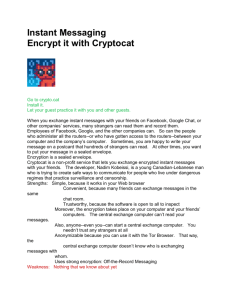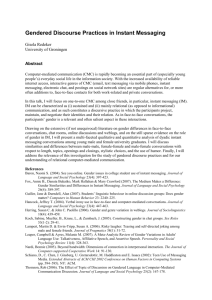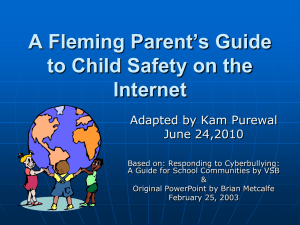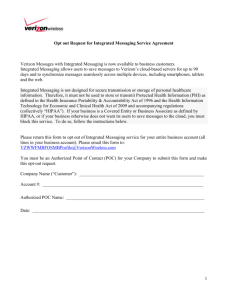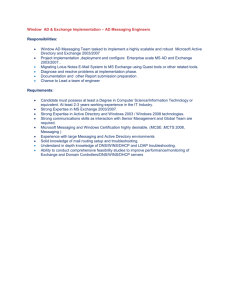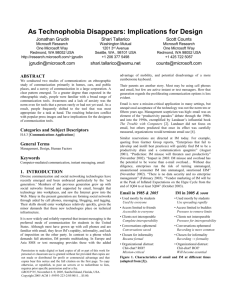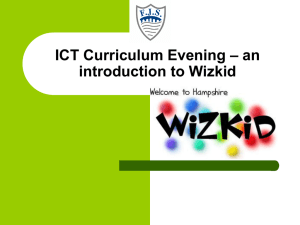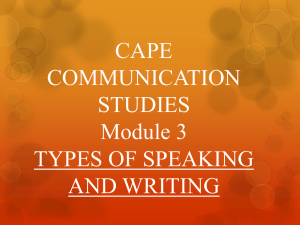Abstract - ResearchOnline@JCU
advertisement
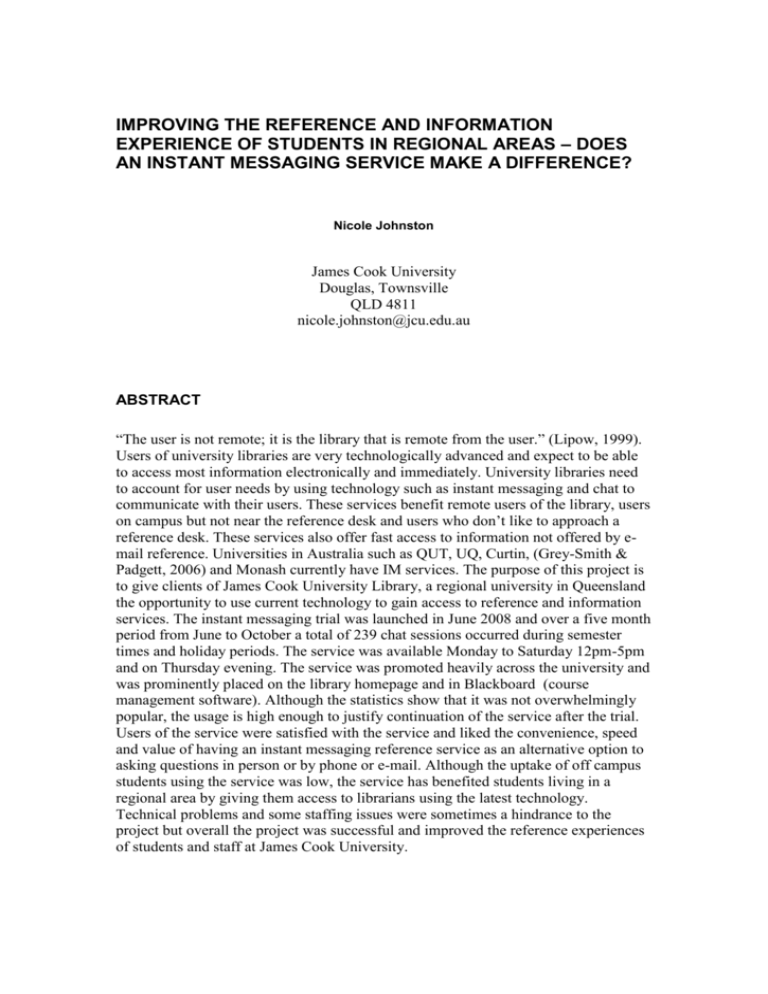
IMPROVING THE REFERENCE AND INFORMATION EXPERIENCE OF STUDENTS IN REGIONAL AREAS – DOES AN INSTANT MESSAGING SERVICE MAKE A DIFFERENCE? Nicole Johnston James Cook University Douglas, Townsville QLD 4811 nicole.johnston@jcu.edu.au ABSTRACT “The user is not remote; it is the library that is remote from the user.” (Lipow, 1999). Users of university libraries are very technologically advanced and expect to be able to access most information electronically and immediately. University libraries need to account for user needs by using technology such as instant messaging and chat to communicate with their users. These services benefit remote users of the library, users on campus but not near the reference desk and users who don’t like to approach a reference desk. These services also offer fast access to information not offered by email reference. Universities in Australia such as QUT, UQ, Curtin, (Grey-Smith & Padgett, 2006) and Monash currently have IM services. The purpose of this project is to give clients of James Cook University Library, a regional university in Queensland the opportunity to use current technology to gain access to reference and information services. The instant messaging trial was launched in June 2008 and over a five month period from June to October a total of 239 chat sessions occurred during semester times and holiday periods. The service was available Monday to Saturday 12pm-5pm and on Thursday evening. The service was promoted heavily across the university and was prominently placed on the library homepage and in Blackboard (course management software). Although the statistics show that it was not overwhelmingly popular, the usage is high enough to justify continuation of the service after the trial. Users of the service were satisfied with the service and liked the convenience, speed and value of having an instant messaging reference service as an alternative option to asking questions in person or by phone or e-mail. Although the uptake of off campus students using the service was low, the service has benefited students living in a regional area by giving them access to librarians using the latest technology. Technical problems and some staffing issues were sometimes a hindrance to the project but overall the project was successful and improved the reference experiences of students and staff at James Cook University. N. Johnston BODY OF PAPER Introduction Instant Messaging is a popular form of communication in today’s technological society. A 2005 Pew Internet report “Teens and Technology” noted that 75% of online teens use instant messaging and 42% of online adults use IM. (Lenhart et al, 2005) The Pew internet report was confirmed by an AP-AOL survey published on December 07, 2006 which found that 44 percent of teen and adult IM users under age 30 log on to instant messaging at least several times a day. (AP-AOL, 2006) A number of university libraries now use Instant Messaging and Chat services to communicate with students and users to answer reference and information queries. This project was funded through the Australian Library and Information Association (ALIA) through the Ray Choate scholarship. The project manager was given the opportunity to manage a large project that involved marketing and promotion, software installation and maintenance and staff training and management. This project involved setting up a six month instant messaging trial in a regional university including installation of software, training staff, evaluation of this service and collection of user statistics and client survey results. A large proportion of students and users of James Cook University are distance education students or students living in rural or remote areas. They often only communicate with reference and information staff via e-mail or phone. There can be time delays with e-mail response or repeated e-mails to clarify details. Phone calls can also be costly. Having an Instant Messaging service benefits both users and library staff as it allows for real time answers to reference queries. Background James Cook University has two main campuses in Townsville and Cairns and several micro-campuses. Currently around 15, 000 students are enrolled at the university. The trend towards online delivery of courses, students’ preference towards online materials and the popularity of Web 2.0 technology led the library to believe there was a need to provide students with a range of technological resources and services including podcasts, screen casts, SMS notifications, online training and instant messaging. In late 2007 the Ray Choate Scholarship was received from ALIA and enabled the library to conduct a six month instant messaging trial in order to establish if an instant messaging service was a viable and sustainable option for providing reference services to university staff and students. As JCU is a regional university it was also an opportunity to offer students another option to access resources and information if they are physically unable to come to the library. The aim of the trial was also to run the service through both campuses thus sharing the responsibility of the service and giving staff an opportunity to collaborate across the two campuses. 2 N. Johnston The Project After substantial time testing and researching instant messaging client and server software, the open source product Openfire with the Spark client was chosen for the trial. This was chosen because it offered the best choice of features that the librarians wanted in an Open Source software product. This included the ability to transfer calls, keep and send chat transcripts, have multiple users logged in at once and generate canned (generic) responses. For a librarian with no programming skills it was not a simple process to get the service up and running. It required extensive work by an IT programmer to configure, test and install the server and client software. JCU currently has seven liaison/faculty librarians located in Townsville and four in Cairns with several casual/part time staff. It was decided to split the responsibility of the service between the campuses. Staff in Cairns were responsible for the service for two days with Townsville responsible for three days. Staff from both campuses logged on for the Saturday shift. Staff at each campus were given the opportunity to decide how to roster those days. Staff working as liaison librarians also cover shifts on the Infohelp/reference desk and work evenings. For the trial it was decided to run the service from 12pm-1pm Monday-Saturday with an evening added half way through the trial in order to gauge the sustainability of staffing the IM service after hours. The Openfire server records data from the users of the IM service including the chat record and their user ID’s. Only students and staff can use the service. The library asked students to provide their user ID so that users could be contacted if we lost the connection which happened on occasion and for statistical purposes. Survey Monkey was used to collect data from a survey and prizes were offered to encourage students to complete this survey. The instant messaging service was branded as AskNow @ JCU Library and marketed in a number of different ways. Posters, bookmarks and bags were produced and distributed around the university. The bookmarks were a successful marketing tool as they were placed at the autoloan machines and were distributed quickly. It was essential for the project’s success that the service had prominent placement on the library’s website. The AskNow @ JCU library icon was placed on the library’s homepage and permission was received to place the icon in LearnJCU (Blackboard) giving the library direct access to where students access all of their course materials. Library staff also actively marketed the service at meetings with academics and in training sessions. E-mails were also sent to students promoting the service through competitions and as a quick easy way to get answers to their library queries. Fig 1: AskNow@JCU Library Logo Usage Statistics A total of 239 chat sessions occurred in the months from June to October. August, September & October were the busiest months all recording around 70 chat sessions. Larger number of sessions in these months was expected as this was during semester. The Instant Messaging service was launched on the 10th June, but there were a few 3 N. Johnston technical difficulties in the first few weeks including no access to the service from off campus. June and July were the winter holiday break at the university so this also accounts for low numbers. On average during semester the service recorded around 26 sessions per day including Saturday. There was no real pattern to when the chats came in and although an evening shift was added during the trial only a small number of chats were received on this evening. The extended evening hours on Thursday was not heavily advertised so this may have been one reason for the low usage. Chat Statistics 30 2627 25 June 20 July 20 August 15 10 5 7 566 2 8 76 6 45 1 5 34 9 66 12 September 10 7 6 34 4 12 6 5 4 44 2 23 October November O th er te Re fe re nc in g IT En dn o Re fe Re re fe nc re e n -g c Re e en fe er L re aw al nc / Bu e -S sin oc es ia s lS Re ci en fe re ce Re n s ce fe re -S nc cie e nc -M e ed ica l/V et Le nd in g 0 Fig. 2: Chat Statistics The most common queries received were General Reference (82) which included queries about intercampus/offcampus requests, assistance using remote access, assistance finding resources and other general reference queries. Faculty specific queries were usually quite in-depth with 66 Faculty chat sessions recorded. The instant messaging service was marketed as a service that clients could use to contact librarians and staff were happy to see that most clients used the service for this purpose with only 27 of the queries being IT related. In the library the IT/library queries are combined at an Infohelp desk and librarians answer large numbers of IT and general enrolment and university wide queries. See Appendix A for chat conversation examples. Client Characteristics The characteristics of the clients of the instant messaging service was analysed to gain an understanding of who was using the service. 75% of the clients were internal students or staff with only 15% of users being external students. 56% of the users were located in Townsville which is not surprising as it is the main campus. 26% of the users were located in Cairns, the other main campus with a small number of users 4 N. Johnston being located in Brisbane, Mackay & Singapore which are all micro campuses of the university. 72% of the users were undergraduate students with 21% of the users being postgraduates and 7% staff. The courses or subjects the users were studying was spread across all of the faculties at the university with the highest rate of users studying in the area of law, psychology, education, nursing and business. These statistics indicate that users of the instant messaging service tend to be undergraduate students studying internally and study in the faculty of Arts, Education and Social Science and the Faculty of Law, Business and Creative Arts. Study Mode 9% 1% 15% 75% Internal External Block Other Fig. 3: Survey Results – Study Mode 5 N. Johnston Client Location 7% 4% 26% 4% 3% Cairns Tow nsville Brisbane Singapore Mackay Other 56% Fig. 4: Survey Results – Client Location Study Level 7% 21% 72% Undergraduate Postgraduate Staff Fig. 5: Survey Results – Study Level 6 N. Johnston Subject Area Accounting Anthropology Aquaculture 2% 2% 4% 5% 3% Business 1% 3% Chemistry Education 8% Engineering 1% 2% 2% English Environmental Science 4% Indigenous Studies 11% Law Medicine Nursing 11% Occupational Therapy 4% 1% 2% 3% 2% 1% Physiotherapy Psychology Social Work Sociology Tourism Tropical Medicine 10% 2% 18% Vetinary Medicine Zoology Other Fig. 6: Survey Results – Subject Area Survey Results A survey was conducted to gain information from clients on issues such as client satisfaction, advantages and disadvantages of using instant messaging and comments on the instant messaging service. A total of 114 staff and students completed the survey. The largest age group to respond to the survey was 17-21 year old with 37% followed by 30% of respondents being in the 36+ age range. The 22-26, 27-31 & 3235 age groups all had similar numbers of respondents averaging around 10%. It is interesting that the largest numbers of respondents were from the two extreme age groups but this may be due to a number of factors including school leaver undergraduates being familiar with and comfortable with this technology , mature age students and staff completing the survey and marketing of the service to 1st year students. Of the respondents 95% were very satisfied or satisfied with the IM service with only 5% being unsatisfied. Some respondents stated that they were unsatisfied due to being unable to access the chat link and the service being unavailable at certain times. There were technical problems during the trial where the service did become unavailable at times and as the service was not available at all times some students were frustrated by this as they often wanted to use the service at the point of need. 7 N. Johnston 55% of the respondents would like the service to be available at all times including weekends and evenings and although that would be the ideal way to run the service it might not be logistically possible with a small number of staff. 44% of the respondents would like the service to be available Monday-Friday 9am-5pm. The service is currently available 12pm-5pm so increasing the hours to include the morning would be a good option after the trial. When asked what the advantages of using an instant messaging service were, most respondents (40%) thought it was an opportunity to communicate with librarians regardless of their location, with many respondents (40%) liking the idea that instant messaging has a faster response time that e-mail. Other responses included that instant messaging was easier for people who don't like asking for help, problems can be resolved instantly and questions can be asked in real time and that some students preferred to communicate via chat rather than through the phone. Respondents felt that there were some issues that would discourage them from using the instant messaging service including the lack of a 24/7 IM service (38%), no access to the service in the evenings (26%), slow or expensive broadband (19%) and no access to the internet (17%) The lack of access to the internet and slow or expensive broadband are issues for students studying and living in regional areas. This issue is difficult for the library to address if students have no access to these services or cannot come onto campus to benefit from the university's internet access. These students will probably have no option as to whether they can take advantage of new technological services offered by the library and other student services. Other issues that discouraged the respondents from using the service were if the service was unavailable when they wanted to use it and if their question was unanswered. Respondents were asked to add any additional comments on the service and most of the comments were positive with a large number of respondents commenting on the benefits of the service including comments such as "Access to information in real time is very convenient and useful", "I could ask a question when ever I liked and I didn't have to come into the library, "I found it was a quick and very easy way to communicate what I needed and the staff were excellent at helping me find the information I need", One external student commented: "Advanced communication always appreciated. As an external student it gives me a feeling of being in touch." Several respondents thought that the service needed to be available more especially in the evenings and one respondent commented that with the increasing flexibility of study and increase in external students, greater availability of the service would be helpful. Overall respondents were happy with the service and could see the benefits of having access to an instant messaging service at the library but felt that the service needed to be available more than it is currently. Staff Evaluation Liaison librarians and other casual staff working on the reference desk who participated in the trial completed an evaluation of the IM service and software. There were differing opinions on how the staff felt the IM service should be rostered. Some staff felt that the service should be available whenever the service points were open and all staff available on both campuses should log in when they were available. Some staff felt that staff rostered on the Infohelp desk should staff the service while 8 N. Johnston others felt that it was difficult to do this especially when the desk is busy with face to face and phone queries. All staff agreed that more than one librarian should be rostered on at one time as currently sometimes only one librarian is rostered on and they have no back up. Librarians also had differing opinions on what times the service should be available but the consensus was that it should be available when the library's service points are open including weekends and evenings although some staff felt that logistically it would be hard to maintain this due to low staffing levels and staff commitments in other areas. Currently the IM service is staffed mostly by liaison librarians so it was suggested that the service could expand to include library staff from other areas of the library. All of the staff were comfortable after some practice with using the service and found the system easy to use although not always totally reliable. Staff were comfortable asking users for e-mail addresses if they didn't know the answer to a question or if the query was a difficult question that required some research. The most popular features of the Spark/Fastpath system included the ability to transfer calls to other librarians especially for subject specific queries and that clients did not need to download any software, the ability to view chat history and the ability to invite other librarians into a conference call. The project manager also liked how the server kept records of conversations, and had the ability to add features to the client window. All of the staff felt that having an IM service was a valuable addition to client support at the library. One staff member commented that "we have a variety of clientele who like to communicate in different ways and for those clients who don't like face to face contact or want a service faster than e-mail, this is ideal." One librarian noted that the service was great for clients who have a point of need question that they need answered quickly. Another staff member commented that she thought that service had brought us up to date with other modern library services. Project Outcomes The project has been a successful way of offering clients of the university library an alternative way to communicate with librarians. The user statistics and data has provided the library with invaluable information on what our users want in an instant messaging service and which users are utilising this reference service. This information can be used to improve the service in the future and provide strategic directions for future marketing and promotion of the service. During the course of the trial the different campuses trialled different forms of rostering staff for the service. One way was to roster a librarian to be on duty for a period of time and the other way was that anyone who was available would log in to the system (the chaos theory). Both systems had their problems as 11 chat sessions went unanswered when staff on one campus used the chaos theory and on the other campus there were problems filling every shift. The survey results indicate that users would like the service to be available for longer hours so it is recommended that when the Infohelp desk is staffed the service is available and that librarians on both campuses log on to the system whenever they are available. It could be made clear to users that the service may sometimes be unavailable. Although the purpose of this project was to give users of James Cook University Library the opportunity to use current technology to gain access to reference and 9 N. Johnston information services, especially distance education students, the usage statistics indicated that a very high percentage of the students using the service were internal students on both main campuses. After discussion with library staff and academics about the lack of uptake of the service by off campus students the following conclusions were reached. One was that off campus students may not have access to the internet or fast internet especially if living in regional areas or some mature aged students may not be comfortable using this technology. Another conclusion was that the service was not available at their point of need which may have been for example a Monday evening or Sunday afternoon. It is recommended that to increase the number of off campus students using the service the hours needs to be extended and the service needs to be promoted by academics to their distance education students. It is also recommended that library staff promote the service to off campus students when they have contact with those students. Conclusion University libraries in regional areas often do not have the infrastructure or funding to implement technological or innovative reference and information services. This opportunity to trial an instant messaging service at James Cook University has provided invaluable professional development opportunities to library staff and provided users of the library the opportunity to communicate with librarians in real time without having to come into the library. The service had a reasonable rate of queries, on average 2-6 queries per day with the majority of users being undergraduate internal students. Most users were satisfied with the fast, efficient service and in the future the library hopes the service will become more popular and have a higher uptake of users. The instant messaging service has been a beneficial addition to the reference and information services of the library and the aim in the future will be to increase the hours the service is available and to promote this service more to off campus students. The projected outcomes would be the increase of the usage of the service in addition to providing more extended support services to students and staff of the university. Instant messaging along with other forms of communication provides students in regional universities or remote areas the opportunity to receive support and assistance from the library using up to date communication tools. AskNow@JCU library has benefited both staff and students of the university by providing them with a professional service that offers assistance in real-time and has made a difference to some students’ university experience. REFERENCES AP-AOL. (2006). Instant Messaging Trends Survey. Retrieved December 16, 2007 from http://press.aol.com/article_display.cfm?article_id=1138&section_id=15 Grey-Smith, Sue & Padgett, Luke. (2006). Using open-source software@curtin library: instant messaging, podcasts, subject guides, blogs and wiki’s. Library & Information Service, Curtin University of Technology. 10 N. Johnston Lenhart, A, Madden, M & Hitlin, P. (2005) Teens & technology – youth are leading the transition to a fully wired and mobile nation. Retrieved March 15, 2008, from http://www.pewinternet.org/pdfs/PIP_Teens_Tech_July2005web.pdf Lipow, A.G. (1999). ‘In your face’ reference service. Library Journal, 124(13), 50-52. BIOGRAPHY OF PRESENTER Nicole Johnston is currently a liaison librarian at James Cook University in the Faculty of Arts & Social Sciences. Nicole has a Bachelor of Arts from UQ, a Graduate Diploma in Library & Information Studies from QUT & a Masters of Applied Science (Library & Information Management) from Charles Sturt University. After graduating from QUT Nicole taught English in Japan and worked at University College Dublin, James Joyce Library. Upon returning to Australia Nicole took up her position at James Cook University. 11 N. Johnston APPENDIX A Examples of Chat Conversations Question: can you tell me where I could find on line the 2nd reading speech for the Nature Conservation Act 1992 Qld Chat Transcripts [4:52 PM] has joined the room [4:52 PM] has joined the room [4:53 PM] Second readings are usually in Hansard or QLD parliamentary papers. I'll just get the call number [4:53 PM] i need to get it on line [4:54 PM] OK let me check [4:54 PM] thanks [4:57 PM] is it QLD [4:58 PM] http://parliament.qld.gov.au/view/legislativeAssembly/hansard.asp [4:58 PM] yes it is [4:59 PM] Try this website. It is parliamentary debates in QLD. [4:59 PM] thanks [5:01 PM] go to search Hansard and put in the act [5:01 PM] i did - have got 113 hits - thanks for your help [5:02 PM] no worries [5:02 PM] has left the room Question: Hi, I am currently living in Mackay but studying through Townsville, am I able to borrow books from the Townsville Library as I have found that the CQU library does not contain the information I need? Nicole Chat Transcripts [12:43 PM] has joined the room [12:43 PM] has joined the room [12:45 PM] Hi you can certainly borrow JCU books through our Off-campus service. Basically you fill out an online form and we send the books to you. We pay for postage to you, you will need to pay for postage back. [12:45 PM] Full details are on the following page http://www.library.jcu.edu.au/Services/offcamp.shtml [12:49 PM] is that what you were looking for? [12:50 PM] Yes thank you, it will be a great help. Also, as the books get sent to me, is the loan period still two weeks or is it longer? [12:52 PM] If it is a normal book (as in it says the collection is "Main" in Tropicat) you are given a little extra time to receive and send the book back. so yes. be aware though some of our books are 2 day loans and although you are given time to receive and send the book back it is not the two weeks for the normal books [12:53 PM] You can also extend your loan online or phone the Library to renew your books (provided someone has not put a hold on the book behind you) 12 N. Johnston [12:53 PM] ok Thankyou. I think that's it for now [12:53 PM] No problem ! [12:53 PM] that's good. Thanks [12:53 PM] has left the room Question: Hello. I am trying to locate an article from the Sydney Law Review, v. 14, no. 1, March 1992, pg 3. JCU Xsearch had indicated it can be found in Informit (resource: APAFT), but I have tried on a number of occasions, with no result. Please help! Chat Transcripts [4:50 PM] has joined the room [4:50 PM] has joined the room [4:50 PM] Hi there, just one moment while I take a look. [4:50 PM] Thank you [4:52 PM] It looks as though we don't have access to issues from 1992 online. We do however have that particular issue in hardcopy in the library. Take a look at this link: http://hip.jcu.edu.au/ipac20/ipac.jsp?session=1M1930144904P.597494&profile=t&uri =link=3100007~!85206~!3100001~!3100002&aspect=subtab80&menu=search&ri=1 &source=~!horizon&term=Sydney+law+review&index=PJTITL [4:53 PM] Thanks very much. I have printed the link and will come in to take a copy. This instant messaging is a fabulous resource. Thanks again. Donna. [4:53 PM] Your welcome. Glad I could help. [4:54 PM] has left the room Hi, Does the JCU Library hold any Davidson Films Inc DVD's on the famous psychological theories by Erikson, Piaget, Skinner or Vygotski? Chat Transcripts [1:24 PM] has joined the room [1:24 PM] has joined the room [1:24 PM] Please wait a moment, I'll get back to you as soon as possible. [1:24 PM] hello hang on and I will check for you [1:24 PM] thanks [1:25 PM] i have just checked piaget and we have couple of videos by davidson, for instance: Piaget's developmental theory [videorecording] : an overview / written and narrated by David Elkind. [1:26 PM] and this one: Play [videorecording] : a Vygotskian approach / with Elena Bodrova and Deborah Leong. [1:26 PM] and this: Using what we know [videorecording] : applying Piaget's developmental theory in primary classrooms / with David Elkind. [1:26 PM] is that the sort of thing you are after [1:26 PM] sure is. [1:27 PM] and this skinner one: B.F. Skinner [videorecording] : a fresh appraisal. [1:27 PM] most seem to be video rather than dvd [1:28 PM] can't seen any on erikson [1:28 PM] I'm an external student...how do i do a search and find these? As I guess I will have to put a request in to the external librarian to have them sent out. 13 N. Johnston Video's are fine. [1:28 PM] yes best to put in an off campus request [1:29 PM] basically the easiest way to find video dvd in the catalogue is to search tropicat and type in the keyword for instance: piaget [1:29 PM] and then when you get the list of results use the limit by box (on the right) and select video, DVDs etc [1:29 PM] this will give you the list that you want [1:30 PM] do you want to try that while I stay on line and see if you can find what you are after [1:30 PM] No, I'm sure that will be fine, thanks for your help. [1:31 PM] ok get back to me if you have any problems [1:31 PM] Will do,. [1:31 PM] has left the room 14
